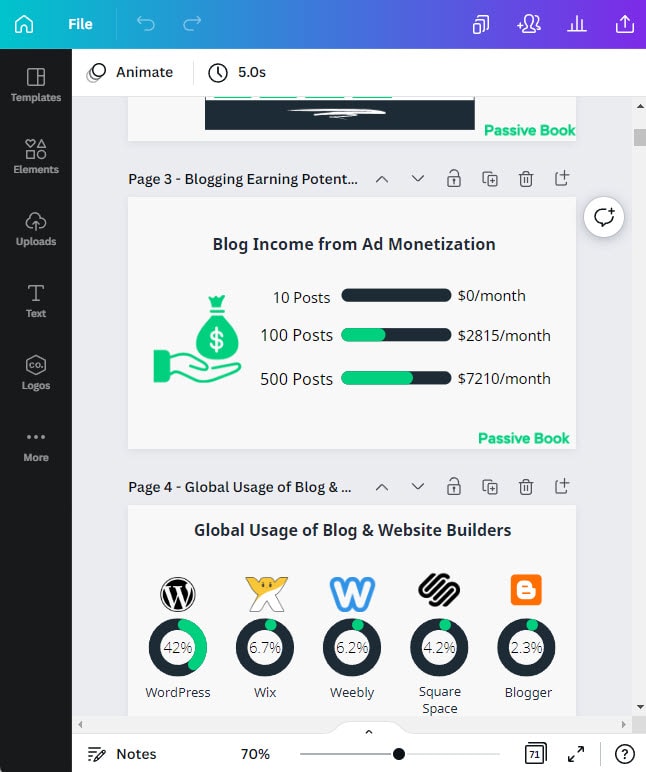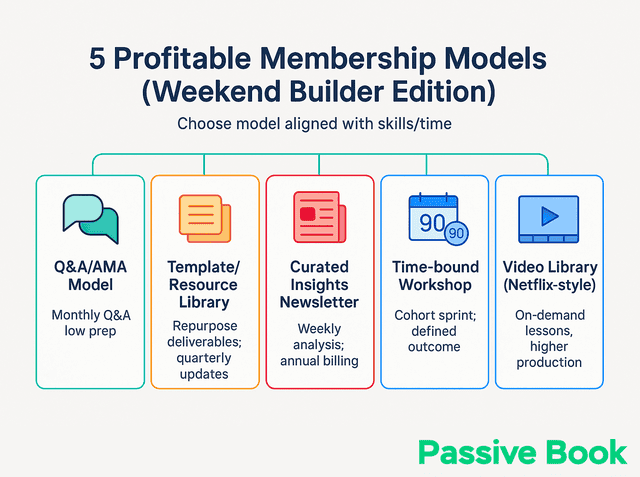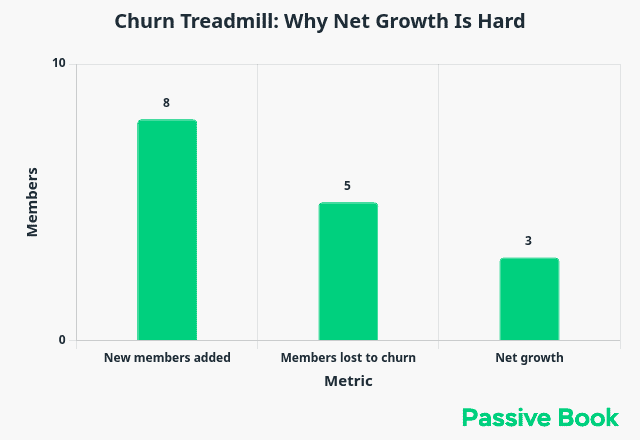I’ve spent over a decade testing nearly every online business model you can imagine. Courses, affiliate marketing, blogging, digital products and other ways to make money online. Each one promised freedom and recurring revenue. But membership sites always felt different because they demand something scarce – your consistent attention every single month.
If you’re working a full-time job and carving out weekends to build something, that ongoing commitment either becomes your sustainable income engine or the thing that burns you out in six months.
The question isn’t whether membership sites can be profitable. They absolutely can. The real question is whether they align with your available time, existing skills, and tolerance for the recurring responsibility of showing up for paying members month after month.

- •What Is a Member Site?
- •Why They Matter [year]
- •How They Make Money
- Startup Costs <$200
- •Time Investment
- 5 Profitable Membership Models
- •The Profitability Math
- •The Churn Problem
- •Member Sites Vs Other Business Models
- •Memberships Make Sense If
- •Choose Another Model If
- •Min Viable Launch Plan
- •What Next?
What Is a Member Site?
A membership site operates on recurring subscriptions. Members pay a monthly fee for exclusive content, resources, or community access. Think of platforms like Netflix or Patreon, but you own the infrastructure and keep most of the revenue.
The key difference from one time products is the ongoing value delivery. Members expect fresh content, updated resources, or continuous community access. They’re not buying a finished course they complete and forget.
Pre-created content becomes your leverage. You record a training video once, and 50 members access it. This scales beyond your personal hours, but only if you build a content buffer before launch.
Why They Matter 2025
The subscription economy grew 435% over the past decade, proving consumers have shifted to recurring payment models. This isn’t a temporary trend. People now expect to subscribe rather than buy outright.
Predictable recurring revenue beats the feast-or-famine cycle of freelancing or one-off product launches. Weekend builders can start small with realistic targets.
100 members at $29/month generates $2,900 monthly-meaningful income potential without needing thousands of followers.

Brennan Dunn launched Double Your Freelancing membership in 2013 as a weekend side project while maintaining freelance clients. Starting with 300 email subscribers and 4 weeks of pre-created lessons, he converted 37 founding members at $49/month, generating $1,813 in monthly recurring revenue.
Within 18 months of weekend-only work, he grew to 120+ members earning $5,880 monthly before eventually scaling to $30k+ monthly.
His case shows membership sites reward consistency over virality. You don’t need a massive audience launch. You need a small group willing to pay for ongoing value.
How They Make Money
SarahBethYoga transformed her YouTube following into a membership generating six-figure revenue. She layered multiple revenue streams beyond the base monthly fee.
Premium tiers with more personalized content, downloadable workout calendars, and annual payment discounts created multiple price points.
This is where membership sites outperform one time products. Member lifetime value compounds over time. A member paying $29/month who stays for 12 months generates $348 total revenue. That same customer buying a $197 course gives you one payment.
Most weekend builders should target 50-100 members at $25-35/month within the first year. This range generates $1,250-3,500 monthly revenue while maintaining a manageable 8-12 hour monthly workload. It’s meaningful income without requiring you to quit your day job.
Understanding what people want from a membership is transformation and not information determines whether they stay or cancel within 90 days. Your membership makes money when members see continuous progress month after month.
Startup Costs <$200
Your primary expenses break down into five categories. Hosting for your website, a membership plugin or platform, email marketing tools, payment processor fees, and content creation software. No manufacturing costs. No shipping logistics.
This makes membership sites accessible for bootstrap builders with limited capital. You’re trading money for time, investing in tools that automate member management instead of hiring staff.
Platform & Hidden Costs
Pricing verified October 2025. Visit platform websites for current rates as pricing changes periodically.
Bluehost WordPress hosting starts at $2.99/month with free SSL certificates and one-click WordPress installation. This handles your website foundation without technical complexity.
For WordPress users with under $100/month budgets, Paid Memberships Pro offers a free core plugin with paid add-ons only if you need advanced features. You start with $0 platform costs and add functionality as revenue grows. Alternatively, MemberPress costs $179.50/year if you can afford the upfront investment, but that’s 1.8 months of tool budget for most weekend builders.
Patreon handles infrastructure if you want zero technical setup, but they take 5-12% of your revenue plus standard payment processing fees. At 50 members paying $29/month ($1,450 gross), Patreon‘s 8% tier costs you $116 monthly versus Paid Memberships Pro’s $0 or MemberPress’s flat $15/month cost.
The $100+ monthly difference matters when you’re bootstrapping, but Patreon‘s zero-setup appeal is worth it if WordPress intimidates you.
ConvertKit email marketing offers a free tier supporting up to 10,000 subscribers. You only pay when you grow beyond that threshold, making it perfect for weekend launches.
Stripe payment processing charges 2.9% plus $0.30 per transaction automatically. This cost is unavoidable regardless of which platform you choose.
You’ll also need standard legal pages including a privacy policy and terms of service, which you can generate using free templates from Termly or TermsFeed.
Content creation tools add another layer. Screen recording software, video editing subscriptions, and graphic design tools cost $10-30/month combined. You can start with free options like OBS for recording and Canva‘s free tier.

The hidden cost nobody discusses is member support time. You’ll spend hours helping people with login issues they caused by using their dog’s name with 17 variations as passwords. This isn’t a one-time setup task. It’s an ongoing operational expense measured in your weekend hours.
Time Investment
Creating a membership site while working full-time means every hour counts. The time commitment splits into two phases with ongoing monthly commitment to creating content for your members.
Pre-launch requires 20-30 hours total spread over 4-6 weekends. You need to create your first 4-6 weeks of content completely before opening enrollment. This buffer prevents the panic of creating content while managing new members.
Monthly content creation demands 6-10 hours for one substantial training video plus downloadable materials. This assumes you’re efficient with recording, editing, and uploading. If you’re learning video editing simultaneously, double that estimate.
Community management consumes 3-5 hours weekly responding to member questions and moderating discussions. This ongoing responsibility never disappears. Members expect responses within 24-48 hours.
Paul Jarvis documented his exact time investment when launching Chimp Essentials while working full-time. Pre-launch required 25 hours total over 6 weekends: 18 hours recording 6 lessons, 4 hours setting up Convertkit sequences, and 3 hours configuring payment systems. Post-launch, he tracked 6-8 hours monthly: 4 hours creating one lesson, 2 hours answering member questions, and 1 hour handling billing and technical issues.
Administrative tasks add another 2-4 hours monthly. Billing issues, member onboarding emails, and platform maintenance pile up faster than expected. These aren’t glamorous hours, but they’re necessary for member retention.
Total monthly time commitment: 20-34 hours spread across 8-10 weekend days. This breaks down to 2.5-4 hours per weekend day if you’re consistent. Miss two weekends, and you’re working 5-6 hour days to catch up, which triggers burnout for most weekend builders.
5 Profitable Membership Models
Justin Welsh built a seven-figure solopreneur business combining multiple membership and course offerings. His success came from choosing models that matched his existing skills rather than learning entirely new capabilities.
Choosing between membership sites and other digital products or online business models depends on matching your existing strengths. If you’re a fast writer, the newsletter model fits better than video production. If you already have client deliverables, the template library model launches fastest.

Q&A/AMA Model
Members submit questions via Google Forms or email, and you answer in monthly video sessions or written format. This model requires zero upfront content library. You start with just the promise of monthly Q&A access.
Pricing ranges from $29-97/month depending on your expertise depth and how personalized responses are. Higher prices work when you’re answering specific, advanced questions rather than general beginner topics.
Dickie Bush runs Ship 30 for 30’s premium community, which includes monthly live Q&A sessions. Members submit questions via Google Forms throughout the month, and he dedicates one 90-minute session monthly to answer them.
This low-prep model requires zero upfront content. He launched with just the promise of monthly Q&A access.
The beauty of this model is flexibility. If you have a busy month at your day job, you can batch record answers in one weekend session. No ongoing content calendar to maintain.
Template Library Model
This is the fastest model to launch because you repurpose work you’ve already created. Package downloadable worksheets, scripts, trackers, planners, or swipe files that members use repeatedly.
This model is fast to create initially because you can repurpose existing client deliverables or create 10-15 core templates in a focused weekend.
Designer Rachel McNaughton offers a template membership with social media templates, brand guides, and proposal templates. She launched with just 12 core templates repurposed from freelance work, charging $27/month.
She batches quarterly template creation during one weekend, spending time creating 4-5 new resources. She now serves 180+ members generating $4,860 monthly with minimal ongoing time commitment.
This model works because templates are one-time creations with quarterly updates. You add new resources based on member feedback, but there’s no pressure to create fresh content every single week.
Newsletter Model
Lenny Rachitsky launched his paid newsletter in April 2020 as a weekend side project while working full-time at Airbnb. He published one deep-dive post weekly for product managers, charging $15/month or $150/year.
Within 18 months of weekend-only work, he grew to over 5,000 paid subscribers, generating more than $75k monthly before transitioning full-time.
This model delivers monthly industry analysis, trend reports, or curated opportunity roundups members can’t find elsewhere. Your value comes from synthesis and pattern recognition, not creating entirely original research.
Require annual payment upfront to reduce chargeback issues and ensure member commitment. Monthly billing on newsletters triggers higher cancellation rates because the perceived value fluctuates week to week.
He batches content creation and focuses on weekly publishing, not daily. This cadence works perfectly for weekend builders who need predictable content schedules.
Workshop Model
Here’s a clever twist: run your membership as a time-bound sprint instead of infinite content. Structure your membership as a 30-90 day program with a concrete outcome delivered through membership infrastructure.
This is easier to sell than sprawling content libraries because it has a clear beginning, middle, and end.
Business coach Megan Minns runs Blog to Biz Hive as a 90-day workshop delivered through a membership platform. She launches quarterly in January, April, July, and October, creating predictable 4-week intensive work periods followed by 8-week recovery phases.
Members pay $297 for 90-day access.
She runs it entirely on weekends, batching live sessions one Saturday per month during active cohorts. This creates natural work sprints with built-in recovery time, preventing burnout.
The workshop model suits weekend builders because you’re not promising infinite ongoing content. You deliver a focused transformation, then repeat the same content with the next cohort.
Video Library Model
The Netflix model works if you can batch-create video content efficiently. On-demand video accessible anytime through a member dashboard works best for fitness, yoga, creative skills, or technical training with repeatable processes.
Members expect higher production quality compared to raw Q&A recordings.
Yoga With Adriene built membership platform FWFG starting with simple YouTube videos filmed in her living room with natural lighting. She launched a $9.99/month membership offering structured calendars and exclusive series using just a basic Canon DSLR camera ($400), lapel microphone ($50), and iMovie editing (free on Mac).

She batches filming by recording 8-12 videos in one weekend day, then schedules releases throughout the month. Total equipment investment stayed under $500, proving you don’t need a professional studio to start.
This model demands the highest ongoing time commitment because members expect regular new video releases. You need discipline to batch-create content ahead of your publishing schedule.
The Profitability Math
Average membership sites price between $29-200/month depending on niche and transformation value. Fitness and business skills command higher prices than hobby-based memberships.
Break-even calculation is straightforward. If your startup cost is $300 and you charge $29 monthly, you need 11 members to recover your initial investment. After that, every new member is profit minus ongoing platform costs.
Acquiring 11 members takes 2-4 months if you’re converting an existing email list of 100-200 subscribers. Without an audience, expect 4-6 months of consistent weekend marketing before hitting break-even.
You need 75-100 members within 6 months generating $2,175-2,900 in gross monthly revenue. After deducting platform costs ($0-30), email marketing ($0-29), hosting ($3-10), and payment processing fees (3%), your net monthly profit ranges from $2,050-2,750.
Realistic ROI timeline for weekend builders:
- Month 1-2: $0-300 (5-10 founding members).
- Month 3-4: $400-800 (10-20 members with 10% churn).
- Month 6-8: $1,200-2,000 (30-50 members with stabilized retention).
- Month 12: $2,500-4,000 (60-100 members if you maintained consistency).
The profitability math changes dramatically based on churn rate. Losing 5 members monthly while gaining 8 new ones means you only net 3 members of growth. This makes retention more valuable than acquisition after your first 50 members.
The Churn Problem
2024 SaaS industry benchmarks show average annual churn rates hover around 10-14%, meaning you lose 1 in 10 customers yearly. 2024 consumer research from Recurly found one in three Americans cancel subscriptions to save money during economic pressure or lifestyle changes.
Five percent monthly churn means you must constantly acquire 5 new members per 100 just to maintain your current revenue. You’re running on a treadmill that never stops.
Launching without a pre-built audience is the fastest path to failure. Cold traffic converts at 1-2% compared to 10-20% from an engaged email list. You need 5,000-10,000 cold visitors to get your first 50 members versus 250-500 warm subscribers.
Inconsistent content delivery kills memberships faster than poor quality. Members cancel when promised monthly value doesn’t materialize by the expected date. They’re paying for reliability, not perfection.
Overwhelming members with too much content drives cancellations faster than delivering too little. When you dump 40 videos in Month 1, members feel behind before they start. They cancel out of guilt, not dissatisfaction.
Competing on price alone attracts tire-kickers. Memberships priced at $10-20/month have the highest churn rates because members don’t value what costs less than their daily coffee.
ConvertKit’s Nathan Barry analyzed common membership failures and found inconsistent content delivery was the number one killer. Creators who missed their promised monthly delivery within the first 3 months experienced 40-60% member churn.
He documented one productivity membership that launched with 200 founding members but delivered Week 3 content five days late, resulting in 42 cancellations-21% instant churn.
The primary complaint was unreliable delivery schedules.

The lesson is brutal: consistency matters more than quality in the first 90 days. Members will tolerate imperfect content if it arrives when promised. They won’t tolerate perfect content that shows up whenever you find time.
Member Sites Vs Other Business Models
Choosing between membership sites and other digital products or online business models depends on your working style, time availability, and revenue timeline expectations. Each model rewards different strengths and punishes different weaknesses.
Revenue predictability varies significantly. Memberships offer recurring income but demand continuous work. Other models might be semi-passive or project-based with different cash flow patterns.
Consider your natural strengths and constraints before committing to membership infrastructure. The wrong model for your situation guarantees failure regardless of effort.
Online Courses: Offer one time payments of $200-500, requiring less ongoing maintenance after launch. You create the content once, then focus on marketing and occasional updates.
Courses become semi-passive income. You update content annually based on feedback versus creating fresh material monthly. This suits weekend builders who want focused launch periods followed by quieter maintenance phases.
Blogging monetizes through display ads, affiliate commissions, or sponsored content over extended timelines. Revenue grows slowly, but the financial investment is minimal-just hosting and a domain name.
Blog revenue builds gradually through search traffic. You might earn $50 monthly in Month 6, $200 in Month 12, and $800 in Month 24. This patience suits builders who prefer compounding growth over immediate monetization. Michelle Schroeder-Gardner of Making Sense of Cents earns over $50k monthly from blog affiliate income with 40-60 hours of monthly investment. She deliberately chose not to launch a membership despite having a large audience.
Blogs offer three advantages: no customer support burden for affiliate income, content remains evergreen generating income for years, and she can take month-long breaks without disappointing paying members expecting fresh content.
Freelancing or consulting trades time for immediate money with no upfront content creation. You get paid this week for work delivered this week. There’s no 3-6 month runway before revenue starts.
Services require no platform costs, payment processors, or content delivery infrastructure expenses. Your startup cost is zero if you have a laptop and internet connection.
Memberships scale beyond personal hours but demand 3-6 months before reaching profitability thresholds. You’re investing time upfront for future recurring revenue, not immediate cash.
Paul Jarvis transitioned from $150/hour client consulting to his Chimp Essentials membership specifically because freelance client work consumed entire weekends with calls, revision requests, and delivery deadlines. His membership initially generated less monthly income ($2,800 from 40 members versus $4,800 from 2 retained clients) but reclaimed 15+ hours weekly by delivering pre-created content instead of custom client work. This gave him time freedom to grow his business with other revenue streams.
Memberships Make Sense If
✅You have an existing audience of 500+ engaged email subscribers or 2,000+ social media followers who actually read your stuff (not just like and scroll). Launching to cold traffic means buying expensive ads to acquire your first members. Warm audiences convert at 5-10 times higher rates.
✅You can create content faster than delivering one-on-one services to individual clients, memberships will make sense. If you already create tutorials, write detailed emails, or record training for clients, memberships let you package that work once and sell it repeatedly.
✅You are comfortable with technology including setting up payment systems and troubleshooting login issues. If WordPress, Stripe integration, and basic email automation feel manageable, you’ll handle the technical requirements fine.
✅You have an expertise that you can teach monthly versus one comprehensive transformation better suited for an online course. Ask yourself: do I have 12 distinct topics to cover, or is this really a 6-week intensive program?
Choose Another Model If
⛔Your audience struggles to afford $25-35/month recurring charges without financial stress.
⛔Your followers are students, early-career professionals, or in lower-income countries, they’ll cancel within 2-3 months regardless of value delivered.
⛔You prefer deep-dive projects over continuous content production on a predictable monthly schedule. Some creators thrive on variety and project-based work. Memberships demand showing up every month like clockwork.
⛔You have fewer than 100 engaged email subscribers to launch with. Realistic conversion expectations are 10-20% for warm audiences. Launching with 50 subscribers means 5-10 founding members-not enough to sustain motivation through the difficult early months.
⛔Available weekend time is sporadic rather than consistent 8-10 hours every single week. Memberships punish inconsistency harder than any other online business model. If your weekends vary wildly due to family commitments or seasonal work demands, choose a model with more flexibility.
Min Viable Launch Plan
ConvertKit research shows successful membership launches require 300-1,000 engaged email subscribers minimum for sustainable founding member conversion rates. Below that threshold, you’ll struggle to get enough members to make the ongoing effort worthwhile.
Create 4-6 weeks of content before launch. This keeps you ahead of delivery schedules and prevents the panic of creating content while managing new members. You need breathing room.
Pre-launch phase needs 20-30 hours total over 4-6 weekends before opening doors. Break it down: create content upfront, set up email sequences, configure payment systems, write your sales page, and test the entire member journey yourself.
Launch takes 6-8 weekends working focused 8-12 hour days with clear milestone targets. Weekend 1 is content creation. Weekend 2 is platform setup. Weekend 3 is email sequences. Weekend 4 is the sales page. Weekends 5-6 are testing and pre-launch marketing.
A free video training or webinar converts warm audiences to founding members at 10-25% conversion rates. This live event creates urgency and answers objections in real-time. Record it for replay but emphasize live attendance benefits.
Open enrollment with a deadline creates urgency and decision momentum. A 5-7 day window with a clear deadline works better than evergreen open carts. People need a reason to decide now, not later.
What Next?
You now understand the real economics behind membership sites. The recurring revenue model works if you have the audience foundation, consistent time availability, and tolerance for ongoing content delivery responsibilities.
If you’re still employed full-time and carving out weekends, start by building your email list to 500+ engaged subscribers first. That foundation makes everything else possible. Test your content creation consistency by publishing weekly for 3 months before launching a paid membership. This proves to yourself you can sustain the cadence.
If this guide helped clarify whether membership sites align with your goals, share it using the buttons below. Other weekend builders need this honest breakdown before committing months of work to the wrong model. Drop a comment with your biggest concern about starting a membership site-are you worried about time commitment, audience size, or something else entirely? I read every response.
Share this post with your friends & followers:
